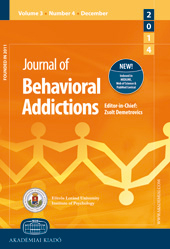Online social networking addiction and depression: The results from a large-scale prospective cohort study in Chinese adolescents
Online social networking addiction and depression: The results from a large-scale prospective cohort study in Chinese adolescents
Author(s): Ji-Bin Li, Phoenix K.H. Mo, Joseph T.F. Lau, Xue-Fen Su, Xi Zhang, Anise M.S. Wu, Jin-Cheng Mai, Yu-Xia ChenSubject(s): Behaviorism
Published by: Akadémiai Kiadó
Keywords: online social networking addiction; depression; longitudinal association; adolescents
Summary/Abstract: The aim of this study is to estimate the longitudinal associations between online social networking addiction (OSNA) and depression, whether OSNA predicts development of depression, and reversely, whether depression predicts development of OSNA. Methods. A total of 5,365 students from nine secondary schools in Guangzhou, Southern China were surveyed at baseline in March 2014, and followed up 9 months later. Level of OSNA and depression were measured using the validated OSNA scale and CES-D, respectively. Multilevel logistic regression models were applied to estimate the longitudinal associations between OSNA and depression. Results. Adolescents who were depressed but free of OSNA at baseline had 1.48 times more likely to develop OSNA at follow-up compared with those non-depressed at baseline [adjusted OR (AOR): 1.48, 95% confidence interval (CI): 1.14–1.93]. In addition, compared with those who were not depressed during the follow-up period, adolescents who were persistently depressed or emerging depressed during the follow-up period had increased risk of developing OSNA at follow-up (AOR: 3.45, 95% CI: 2.51–4.75 for persistent depression; AOR: 4.47, 95% CI: 3.33–5.99 for emerging depression). Reversely, among those without depression at baseline, adolescents who were classified as persistent OSNA or emerging OSNA had higher risk of developing depression compared with those who were no OSNA (AOR: 1.65, 95% CI: 1.01–2.69 for persistent OSNA; AOR: 4.29; 95% CI: 3.17–5.81 for emerging OSNA). Conclusion. The findings indicate a bidirectional association between OSNA and depression, meaning that addictive online social networking use is accompanied by increased level of depressive symptoms.
Journal: Journal of Behavioral Addictions
- Issue Year: 7/2018
- Issue No: 3
- Page Range: 686-696
- Page Count: 11
- Language: English

